
When I think of 1965's Thunderball, the primary image that pops into my head revolves around an endless series of underwater scenes in which discerning actual events becomes a futile exercise. There are other things that happen, and actually this one of the easiest of Bond films to summarize, but the underwater sequences beat you into submission, turning what could be an entertaining Bond installment into a bit of an endurance test. Even Jacques Cousteau would grow tired of the film's propensity to fixate on underwater shots.
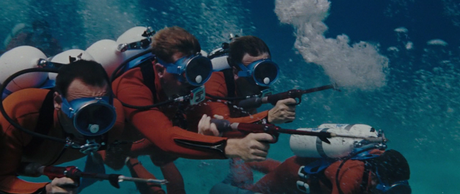
That's not to say there's nothing that works about Thunderball. For a film that feels this bloated, it's plot is relatively straight-forward. SPECTRE's number two, Emilio Largo (Adolfo Celi) steals two atomic bombs, uses them to blackmail NATO into giving them one-hundred million British pounds worth of diamonds. MI6 sends James Bond (Sean Connery) to investigate, and evidence leads him to the Bahamas, where he encounters the villainous Largo, and his mistress, Domino (Claudine Auger). After a series of reviews in which plot summaries are the writing equivalent of performing a backflip while holding sparklers in each hand, it's nice to be able to summarize a plot in just a few sentences. Granted, stealing two atomic bombs involves killing the pilot assigned to fly the jet carrying the two atomic bombs and using plastic surgery to turn another individual into the slain pilot so he can fly in his place and steal the atomic bombs, but this is just a part of the whole "blackmail NATO with nuclear bombs" thing, rather than a complicated side tangent.
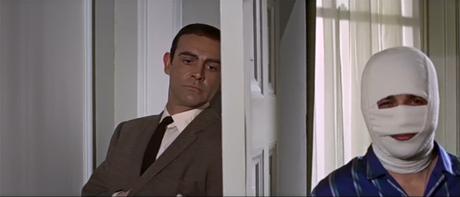
The film opens well, with Bond attending the funeral of a fallen adversary, where he realizes said adversary is not only alive but posing as his own widow. This leads to the pretty hilarious moment in which James Bond punches what appears to be a grieving widow in a black dress and suspiciously opaque veil. There's the nice action-packed bit of fisticuffs, and an escape via jet pack and Aston Martin. With an opening this strong, it would be easy to think we're in store for a real treat of a Bond movie.
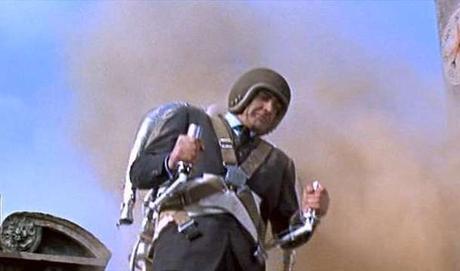
Emilio Largo, with his love of card-playing, his jaunty eye-patch, and his love of shark-filled pools is a worthy entry into the Bond villain cannon, a sign of the film's inherent bombast. The scene in which he gambles against Bond, after Bond not so subtly tips his hand that he knows Largo is a member of SPECTRE, is a film highlight. They engage in an entertaining bit of cat-and-mouse throughout the film.
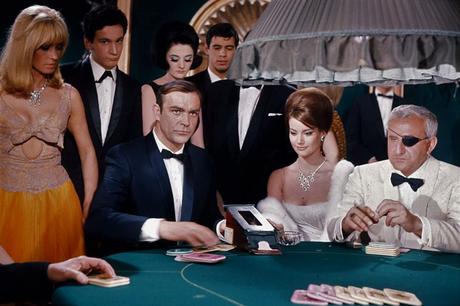
Fiona Vulpe (Luciana Paluzzi), another SPECTRE agent who manages to get ensure Largo's scheme is set in motion serves as another compelling antagonist who manages to mock the trope of Bond basically seducing femme fatales to the righteous side.
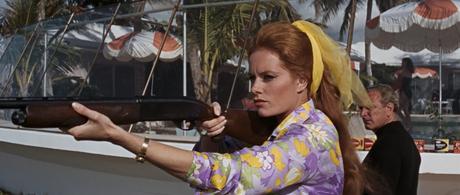
The presence of CIA agent Felix Leiter (here played by Rik Van Nutter) is also always welcome. Auger's Domino is an appealing Bond girl who, once she learns Largo killed her brother, actually has a narrative reason for shifting her alliance to Bond beyond Bond's sexual charisma.

While not as inherently campy as the Bond installments that would follow it, Thunderball signals the campier instincts with which the franchise would run throughout the 1970s. The elements of the Bond franchise that are ready for parody exist here, from SPECTRE's exploding chairs to Largo's shark-infested pool, there's a sense of the ridiculous here. Even Largo's appearance, complete with eye patch, and position as SPECTRE's number two man would inspire the "No. 2" Austin Powers character. Goldfinger created a world that felt more artificial, a bit sillier. After Goldfinger's success, the Bond films appear to make a decision to abandon the relatively serious worlds of Dr. No and From Russia with Love behind for a cinematic world that feels a bit more absurd.
Thunderball may also be the last Bond film in which it seems that Connery actually cares that he's on-screen. The screenplay, as written by Richard Maibaum and John Hopkins, plays to his strengths, allowing his adeptness with the film's frequent quips to compliment his appealing nonchalance. By this point, he was synonomous with the character he was slowly growing to resent, and it's not difficult to see why. His strapping build, Scottish brogue, and general machismo are necessary for the film to succeed, and he exudes charisma whenever he's on-screen. Let's be honest, some of Bond's actions here, including first sexually assaulting and then sexually blackmailing a physical therapist and intruding on a woman's bath, reek of sleaziness to modern eyes.
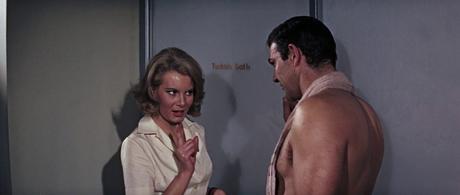
However, Connery's playful charm doesn't totally erase a modern's audiences' discomfort, but makes the moments feel less awful than they might otherwise.
The brevity of the film's plot makes it extra ironic that this was the longest Bond film up to that point, the first one to break the 2-hour mark, and that's all due to underwater sequences that are technically impressive but do little to advance the film's plot and become a bit indistinguishable from one another as the film goes on. Director Terence Young, who had directed the first two Bond efforts, seems so excited about the fact that he can shoot underwater fight scenes that he loses perspective as to how many the film actually needs.
There's an endearing practicality to the film's special effects, with the majority of the effects needing to actually work, including the opening's jet pack, the Aston Martin's ejector seat, and its use of actual sharks, including one that got through the safety plexiglass and nearly took Sean Connery out of commission.

Even those interminable underwater sequences are impressive, if tiring. I don't love the film, but it's impossible not to be impressed with its ingenuity.
Despite Thunderball 's issues, I have to confess a certain fondness for it. So few Bond films are flawless, and excess is this film's biggest flaw, which is pretty easy to forgive. The picturesque vistas are lovely, the Bond girl is appropriately alluring, there are quite a few impressive set pieces, and there's a general sense of fun that's difficult to resist. Beyond that, Connery's cool detachment in the face of madness and absurdity provides a necessary counterweight. A necessary fat trimming that would make the film stronger than it is, but there's fun to be had and there are certainly worse films in the franchise.

